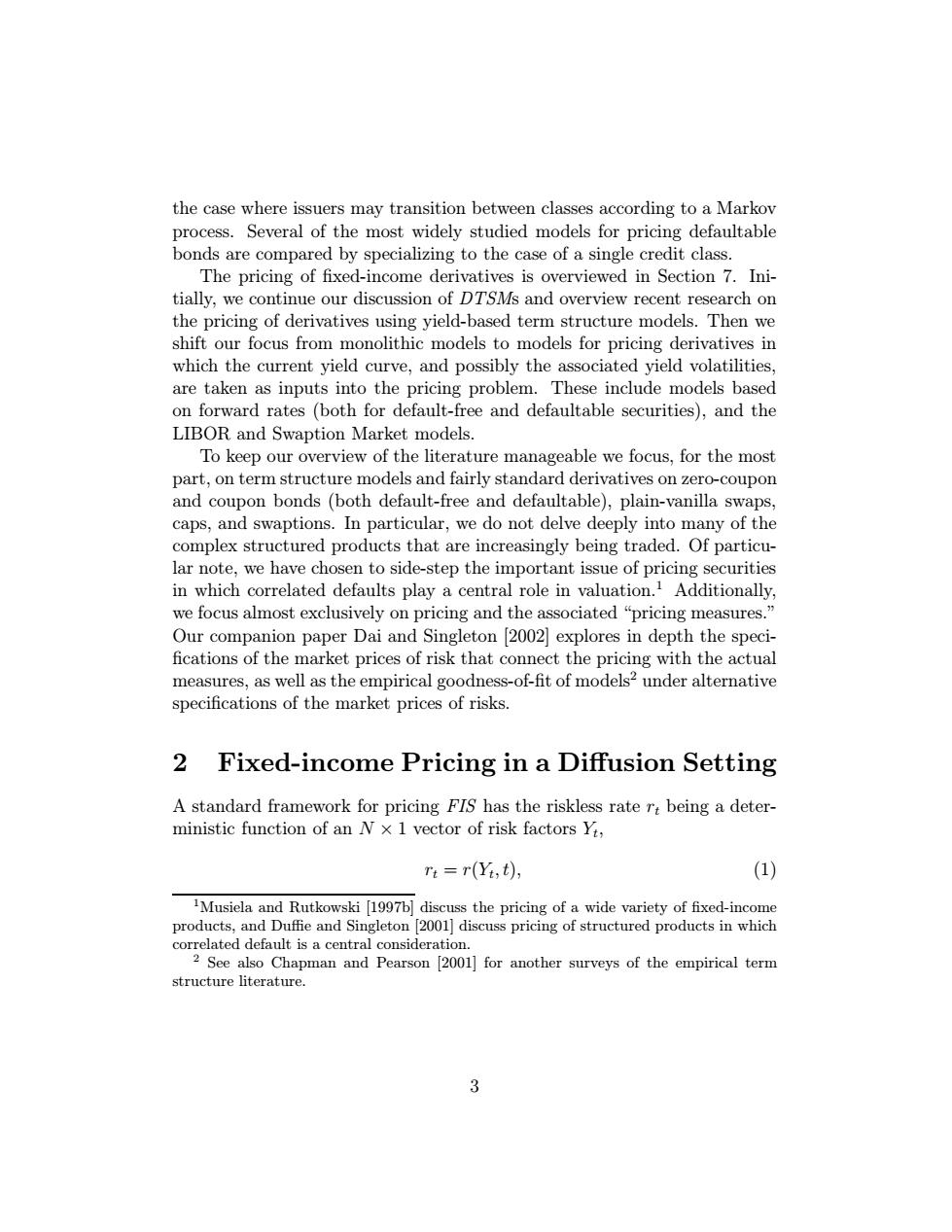正在加载图片...

the case where issuers may transition between classes according to a Markov process.Several of the most widely studied models for pricing defaultable bonds are compared by specializing to the case of a single credit class. The pricing of fixed-income derivatives is overviewed in Section 7.Ini- tially,we continue our discussion of DTSMs and overview recent research on the pricing of derivatives using yield-based term structure models.Then we shift our focus from monolithic models to models for pricing derivatives in which the current yield curve,and possibly the associated yield volatilities, are taken as inputs into the pricing problem.These include models based on forward rates (both for default-free and defaultable securities),and the LIBOR and Swaption Market models. To keep our overview of the literature manageable we focus,for the most part,on term structure models and fairly standard derivatives on zero-coupon and coupon bonds (both default-free and defaultable),plain-vanilla swaps, caps,and swaptions.In particular,we do not delve deeply into many of the complex structured products that are increasingly being traded.Of particu- lar note,we have chosen to side-step the important issue of pricing securities in which correlated defaults play a central role in valuation.Additionally, we focus almost exclusively on pricing and the associated "pricing measures." Our companion paper Dai and Singleton [2002]explores in depth the speci- fications of the market prices of risk that connect the pricing with the actual measures,as well as the empirical goodness-of-fit of models2 under alternative specifications of the market prices of risks. 2 Fixed-income Pricing in a Diffusion Setting A standard framework for pricing FIS has the riskless rate rt being a deter- ministic function of an N x 1 vector of risk factors Yt, Tt=r(Yi,t), (1) 1Musiela and Rutkowski [1997b]discuss the pricing of a wide variety of fixed-income products,and Duffie and Singleton [2001]discuss pricing of structured products in which correlated default is a central consideration. 2 See also Chapman and Pearson [2001]for another surveys of the empirical term structure literature. 3the case where issuers may transition between classes according to a Markov process. Several of the most widely studied models for pricing defaultable bonds are compared by specializing to the case of a single credit class. The pricing of fixed-income derivatives is overviewed in Section 7. Initially, we continue our discussion of DTSMs and overview recent research on the pricing of derivatives using yield-based term structure models. Then we shift our focus from monolithic models to models for pricing derivatives in which the current yield curve, and possibly the associated yield volatilities, are taken as inputs into the pricing problem. These include models based on forward rates (both for default-free and defaultable securities), and the LIBOR and Swaption Market models. To keep our overview of the literature manageable we focus, for the most part, on term structure models and fairly standard derivatives on zero-coupon and coupon bonds (both default-free and defaultable), plain-vanilla swaps, caps, and swaptions. In particular, we do not delve deeply into many of the complex structured products that are increasingly being traded. Of particular note, we have chosen to side-step the important issue of pricing securities in which correlated defaults play a central role in valuation.1 Additionally, we focus almost exclusively on pricing and the associated “pricing measures.” Our companion paper Dai and Singleton [2002] explores in depth the speci- fications of the market prices of risk that connect the pricing with the actual measures, as well as the empirical goodness-of-fit of models2 under alternative specifications of the market prices of risks. 2 Fixed-income Pricing in a Diffusion Setting A standard framework for pricing FIS has the riskless rate rt being a deterministic function of an N × 1 vector of risk factors Yt, rt = r(Yt, t), (1) 1Musiela and Rutkowski [1997b] discuss the pricing of a wide variety of fixed-income products, and Duffie and Singleton [2001] discuss pricing of structured products in which correlated default is a central consideration. 2 See also Chapman and Pearson [2001] for another surveys of the empirical term structure literature. 3